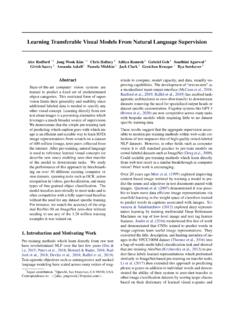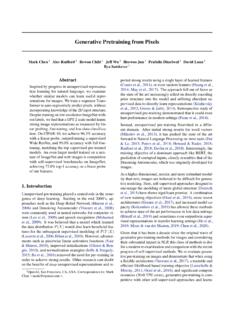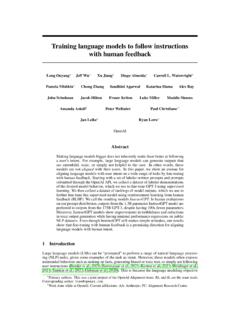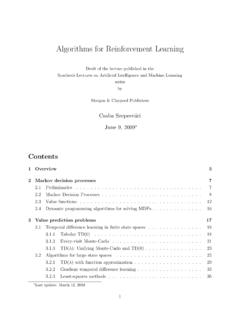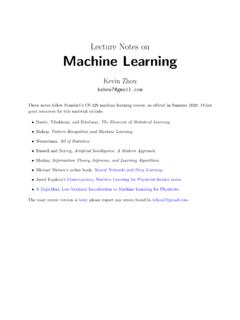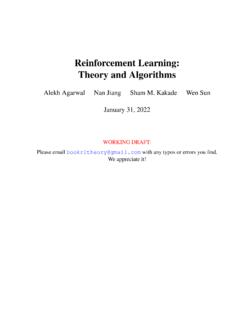Transcription of Benchmarking Safe Exploration in Deep Reinforcement …
1 Benchmarking Safe Exploration in Deep Reinforcement learning Alex Ray Joshua Achiam Dario Amodei OpenAI OpenAI OpenAI. Abstract Reinforcement learning (RL) agents need to explore their environments in order to learn optimal policies by trial and error. In many environments, safety is a critical concern and certain errors are unacceptable: for example, robotics systems that interact with humans should never cause injury to the humans while exploring. While it is currently typical to train RL agents mostly or entirely in simulation, where safety concerns are minimal, we anticipate that challenges in simulating the complexities of the real world (such as human-AI interactions) will cause a shift towards training RL agents directly in the real world, where safety concerns are paramount.
2 Consequently we take the position that safe Exploration should be viewed as a critical focus area for RL research, and in this work we make three contributions to advance the study of safe Exploration . First, building on a wide range of prior work on safe Reinforcement learning , we propose to standardize constrained RL as the main formalism for safe Exploration . Second, we present the Safety Gym benchmark suite, a new slate of high-dimensional continuous control environments for measuring research progress on constrained RL. Finally, we benchmark several constrained deep RL algorithms on Safety Gym environments to establish baselines that future work can build on. 1 Introduction Reinforcement learning is an increasingly important technology for developing highly-capable AI.
3 Systems. While RL is not yet fully mature or ready to serve as an off-the-shelf solution, it appears to offer a viable path to solving hard sequential decision-making problems that cannot currently be solved by any other approach. For example, RL has been used to achieve superhuman performance in competitive strategy games including Go [Silver et al., 2016, 2017a,b], Starcraft [DeepMind, 2019], and Dota [OpenAI, 2019]. Outside of competitive domains, RL has been used to control highly-complex robotics systems [OpenAI et al., 2018], and to improve over supervised learning models for serving content to users on social media [Gauci et al., 2018]. The fundamental principle of RL is that an agent, the AI system, tries to maximize a reward signal by trial and error.
4 RL is suitable for any problem where it is easier to evaluate behaviors (by computing a reward function) than it is to generate optimal behaviors (eg by analytical or numerical methods ). The general-purpose nature of RL makes it an attractive option for a wide range of applications, including self-driving cars [Kendall et al., 2018], surgical robotics [Richter et al., 2019], energy systems management [Gamble and Gao, 2018, Mason and Grijalva, 2019], and other problems where AI would interact with humans or critical infrastructure. Most of the wins for RL so far have been enabled by simulators, where agents can try different behaviors without meaningful consequences. However, for many problems simulators will either not be available or high-enough fidelity for RL to learn behaviors that succeed in the real environment.
5 Equal contribution Preprint. Under review. While sim-to-real transfer learning algorithms may mitigate this issue, we expect that in problems centered on AI-human interaction or very complex systems, challenges in building useful simulators will cause a shift towards training directly in the real world. This makes the safe Exploration problem particularly salient. The safe Exploration problem is a natural consequence of the trial-and-error nature of RL: agents will sometimes try dangerous or harmful behaviors in the course of learning [Hans et al., 2008, Moldovan and Abbeel, 2012, Pecka and Svoboda, 2014, Garc a and Fern ndez, 2015, Amodei et al., 2016]. When all training occurs in a simulator, this is usually not concerning, but Exploration of this kind in the real world could produce unacceptable catastrophes.
6 To illustrate safety concerns in a few domains where RL might plausibly be applied: Robots and autonomous vehicles should not cause physical harm to humans. AI systems that manage power grids should not damage critical infrastructure. Question-answering systems should not provide false or misleading answers for questions about medical emergencies [Bickmore et al., 2018]. Recommender systems should not expose users to psychologically harmful or extremist content [Vendrov and Nixon, 2019]. A central question for the field of RL is therefore: How do we formulate safety specifications to incorporate them into RL, and how do we ensure that these specifications are robustly satisfied throughout Exploration ?
7 The goal of our work is to facilitate progress on this question on several fronts. Towards standardizing safety specifications: Based on a range of prior work, we propose to stan- dardize constrained RL [Altman, 1999] as the main formalism for incorporating safety specifications into RL algorithms to achieve safe Exploration . We clarify that we are not advocating for any spe- cific constraint-based algorithm, but instead taking a position that 1) safety specifications should be separate from task performance specifications, and 2) constraints are a natural way to encode safety specifications. We support this argument by reference to standards for safety requirements that typically arise in engineering design and risk management, and we identify the limitations of alternative approaches.
8 Importantly, constrained RL is scalable to the regime of high-dimensional function approximation the modern deep RL setting. Towards measuring progress: The field of RL has greatly benefited in recent years from benchmark environments for evaluating algorithmic progress, including the Arcade learning Environment [Bellemare et al., 2012], OpenAI Gym [Brockman et al., 2016], Deepmind Control Suite [Tassa et al., 2018], and Deepmind Lab [Beattie et al., 2016], to name a few. However, there is not yet a standard set of environments for making progress on safe Exploration Different papers use different environments and evaluation procedures, making it difficult to compare methods and in turn to identify the most promising research directions.
9 To address the gap, we present Safety Gym: a set of tools for accelerating safe Exploration research. Safety Gym includes a benchmark suite of 18 high-dimensional continuous control environments for safe Exploration , plus 9 additional environments for debugging task performance separately from safety requirements, and tools for building additional environments. Consistent with our proposal to standardize on constrained RL, each Safety Gym environment has separate objectives for task performance and safety. These are expressed via a reward function and a set of auxiliary cost functions respectively. We recommend a protocol for evaluating constrained RL. algorithms on Safety Gym environments based on three metrics: task performance of the final policy, constraint satisfaction of the final policy, and average regret with respect to safety costs throughout training.
10 We highlight three particularly desirable features of Safety Gym: 1. There is a gradient of difficulty across benchmark environments. This allows practitioners to quickly iterate on the simplest tasks before proceeding to the hardest ones. 2. Leike et al. [2017] give gridworld environments for evaluating various aspects of AI safety, but they only designate one of these environments for measuring safe Exploration progress. 2. 2. In all Safety Gym benchmark environments, the layout of environment elements is random- ized at the start of each episode. Each distribution over layouts is continuous and minimally restricted, allowing for essentially infinite variations within each environment. This prevents RL algorithms from learning trivial solutions that memorize particular trajectories, and requires agents to learn more-general behaviors to succeed.



